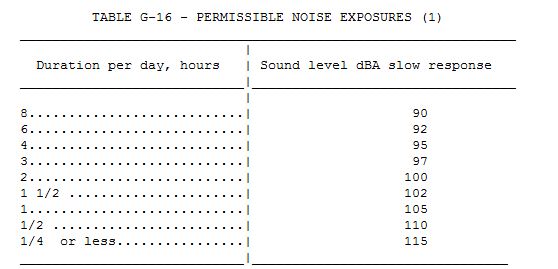As I have said in an earlier post, some OSHA, EPA, and MSHA rules are a good fit. They blend well with health research, scientific technology, good practices, and a low-cost-of-compliance for employers. Other rules are just bad. They are  totally out of date, not protective enough, or just not feasible/practical. Here’s my plug for a good safety manager/industrial hygienist – A good one will know which rules/guidelines to follow.
The New York Times (July 19, 2012, Cara Buckley) recently wrote an article on the US noise standards which are not protective enough for employees. In construction we also have three additional problems.
- hearing loss is expected (or at least assumed in certain fields – carpenters, sheetmetal, ironworkers, etc.) and,
- work shifts are usually over 8-hours. Noise exposure is usually calculated on an 8-hour time weighted average. During the busy months, an 8-hour work day is rare. It’s at least 10, maybe 12-14 hours. This doesn’t allow your ears to “rest” between shifts. For more information on extended work shifts go here.
- extracurricular activities contribute to overall hearing loss – my point is that most construction workers don’t sit at home at the end of their shift. Almost everyone I know in construction is involved in one of these activities: hunting, shooting, motorcycles, water sports, yard work, cars, wood working/cutting, concerts, music, etc. Each of these activities contribute to their overall hearing loss, and again, doesn’t allow your ears to “rest”.
…which reminds me that I need to keep a set of ear plugs in my motorcycle jacket.

Tags: ACGIH, dBA, dosimeters, EPA, hearing loss, IH, noise, OSHA, safety, sound, sound level, standards, TWA
Posted by admin under Hearing Conservation, hearing protection, Noise
Comments Off on Noise Monitoring – FAQ / Q&As
I get the best questions from employees as I’m setting them up to wear a dosimeter. (FYI- this does not really apply to sound level readings, only dosimetry)
- Why do I have to wear the monitor (dosimeter)? Can’t we just place it in the middle of the area?
Ideally we want the dosimeter to measure the individual exposure. Many factors influence the average noise level, including work practices, location (sound bouncing & dampening), height, proximity to others, equipment, etc.
- What is the dosimeter actually measuring?
A dosimeter measure the sound pressure level, measured in decibels A-weighted, dBA (usually). It can record this level and average it (usually) for every 1 minute period. The amount of information it gathers is staggering…and confusing.
- What if we work a longer shift (more than 8 hours) will the results of the noise monitoring be the same?
Yes, the results are (usually) given as an average. So, in theory, if you measure the noise for 15 minutes and it is the same for the next 7.75 hours, it should be the same. However, if you work more than 8-hours a day OSHA actually decreases the amount of noise you can be exposed to. They have a table (G-16)  that attempts to explain it.  If you know the average level of noise (say it’s an average of 95 dBA 8-hour TWA), then you can determine the time you are allowed (answer: 4 hours).
- How often should noise monitoring be performed?
There is not a specific rule from OSHA on how often you must monitor. However, the guideline is yearly. Â Or if/when significant changes occur “which might effect the results of this testing” (I always use this statement in my reports).
- Which individual employees should have their noise level measured?
It is best to let the industrial hygienist make this determination (there are several good reasons). If you are just starting out, they will often choose an average, or those who might have the highest noise level exposures.
- I’m wearing hearing protection, why don’t they take that into account when they determine the average readings?
Your exposure is determined without regard to the specific type of hearing protection used. If you are wearing the wrong type of hearing protection, or if it is worn incorrectly, you could still have this exposure.

